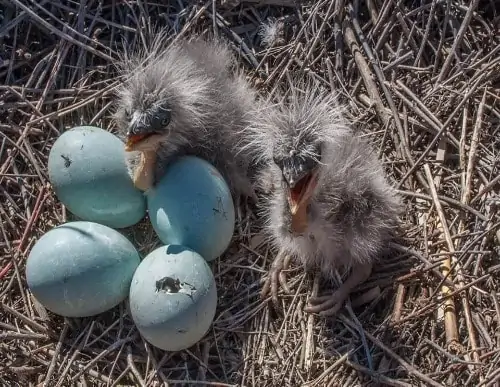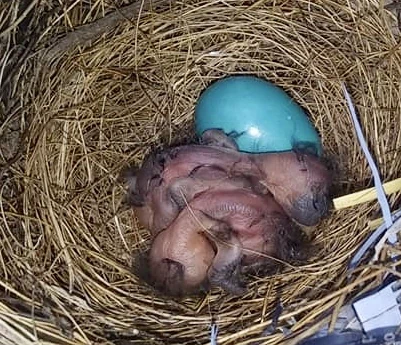It's always a pleasant surprise to peep into a bird's nest and see a blue or purplish egg instead of a white egg.
Also…
Sometimes, you come across a colored egg with speckles, spots, or markings.
No, an Easter bunny doesn't drop these into a nest. Birds can make them as colorful as those of an easter egger.
Do you know what birds lay blue eggs? Let’s discover together.
What Bird Lays Blue Eggs
When you see a blue egg, the next step is to ID it by its size and markings to know the bird that laid it. Here's a list.
1. European Starling
When you look inside a starling's nest, you'll see eggs with a bluish to greenish-white egg color.
Both sexes take turns incubating eggs. They lay between three and six eggs per clutch and have from one to two broods.
They are between 1.1 and 1.3 inches long and 0.8 to 0.9 inches wide, making them large compared to the size produced by other bird species.
2. Eurasian Blackbird
It lays between three and five per clutch, and even though they aren't a bright blue color, they also deserve to be on this list.
They are bluish-green, red speckled eggs.
3. American Robin
A clutch has between three and five, and each robin egg has a length between 1.1 and 1.2 inches and a width of 0.8 inches.
These eggs have a stunning light blue color.
A female bird builds a cup-shaped nest with twigs and mud, then makes the interior soft with a layer of dry grass. A male robin doesn't help in this process.
Watch This!
4. House Finch
You don't have to go far to see house finch nests as it's a backyard bird that nests anywhere. If there's a flock of house finches in your backyard, there's probably one bird nest in your structures.
A finch's eggs have a pale bluish-green color with black or pale purple speckles.
A clutch has two to six small eggs with a width between 0.5 and 0.6 inches.
5. Song Thrush
A clutch has four to five eggs, each about 1.1 inches long.
They are glossy light blue with black or purple speckles.
6. Mountain Bluebirds
When you ask what bird lays blue eggs, you're most likely going to get bluebirds as the answer. You'll rarely come across mountain bluebird eggs that are pure white even though they have the palest of all bluebird eggs.
Mountain bluebirds lay four to eight eggs with a pale blue to bluish-white color.
Fun Fact: Other bluebirds with bluish eggs are the western and eastern bluebirds.
Watch This!
7. Blue Jay
When you peep into such a nest, you'll see bluish ones with brown egg spots.
A blue jay builds a cup-shaped nest up to 25 feet above the ground, and once it lines the nest with rootlets, it lays a clutch of two to seven inside. The eggs of blue jays are between 1 and 1.3 inches long and 0.7 to 0.9 inches wide.
8. Great Blue Heron

They start with a pale blue color and fade as they age since the incubation is about 29 days, about a week shorter than the incubation period of a great horned owl.
This heron nests in trees, bushes, mangroves, or even on the ground. It builds large nests since it's a bird with a bill-to-tail length between 38.2 and 53.9 inches. Consequently, it can build a nest that's about four feet across with a depth of 3.5 feet. Inside, it lays between two and six eggs measuring 3 inches long and 2 inches wide.
9. American Goldfinch
This goldfinch lays small blue eggs in a nest lined with fluffy seedheads.
A nest may have two to seven pale bluish-white ones with faint brown spots. A Lawrence's goldfinch also has colorful eggs.
10. Snowy Egret
Unlike most birds, a male snowy egret starts building a nest before a suitable mate comes along. This bird's clutch has two to six eggs with a length between 16.6 and 1.7 and up to 1.3 inches wide.
Its eggs have a pale greenish-blue color.
11. Gray Catbird

It takes a female gray catbird about five days to build a nest using twigs, mud, grass, and hair. Trash can also become nesting material when a breeding pair inhabits a residential area. This bird then lays one to six eggs barely 1 inch long.
They have a turquoise green color with some red spots.
12. Red-winged Blackbird
A female blackbird builds a nest up to seven inches wide and between three and seven inches deep. This nest serves as a home for the short incubation period of 13 days and the 14-day nestling period.
Each clutch has two to four blue speckled bird eggs whose color ranges from blue-green to gray. The black or brown markings make them unique.
13. Wood Thrush
We can list it among birds that lay blue eggs as it lays turquoise-green ones without markings.
A wood thrush's nest takes three to 6 days to complete, weaving grass, leaves, paper, and mud together. A clutch has three to four eggs that take about half a month to incubate and another 15-day nestling period.
14. Lesser Goldfinch
It's impossible to answer what birds have blue eggs without mentioning several goldfinches. Here's another one that lays up to six eggs per clutch.
They are pale blue-white, unmarked, with a length and width of about 0.4 to 0.6 inches.
A lesser goldfinch builds a nest in four to eight days. The structure of the cup-shaped nest has tree barks, leaves, spider webs, and catkins. Inside is a soft lining of feathers, wool, hair, or rabbit fur.
15. Eastern Bluebird
Its eggs are pale blue, and one clutch has seven of them.
On top of that, a breeding pair may reuse a nest for different broods. To attract a female to a nesting site, a male brings materials to the hole and flutters its wings. Sometimes, this bird uses a nest box instead of building a nest.
16. House Sparrow
The egg color ranges from greenish-white to bluish-white with gray or brown spots.
This bird builds a nest anywhere, even in a building, and you can remove them because the Migratory Bird Treaty Act doesn't cover non-native species. It uses dried material and lines it with feathers and paper. Sometimes, a breeding pair can build beside another mating pair and share a wall.
Why Some Birds Have Blue Eggs
The only way to explain blue speckled bird eggs is to discuss how a bird egg gets its color.
The Cornell Lab notes that pigmentation is the second last step before a protein coating, after which the egg is ready.
Camouflage
It's the best way to confuse predators that love poking their bills into nests. Hence, birds nesting in cavities have white eggs and the ones using open nests have pigmented eggs.
Prevent Parasitism
Even the avian world has some species that want to cut deals. In this case, some parasitic birds dump their eggs in other nests. One known parasite is the brown headed cowbird. A female cowbird doesn't build a nest.
Instead, you'll find a cowbird egg in the nest of hundreds of host species, including the spotted towhee, red-winged blackbird, and song sparrow.
Sometimes, a host species may throw these eggs out or puncture them, but smaller hosts like the yellow warbler have better strategies. They build a new nest over the old one with parasitic eggs.
Birds that don't recognize the parasitic clutch incubate it. Fortunately, the eggs of brown-headed cowbirds hatch fast, so the baby bird gets food from host parents before their incubating clutch hatches.
Protection
It's also probable that the pigment controls the level of ultraviolet rays reaching an embryo. But, all of these arguments are still under research because there are also birds that lay white eggs in open nests regardless of the access granted to predators.
Maybe, these birds protect the clutch round the clock, so there's no need for a pigment as camouflage.
Chicken eggs also have different colors; therefore, the reason might not be camouflage. For example, Araucana chicken has a similar color to Ameraucana chicken. The olive egger lays an olive green egg, and the easter egger produces any color as it has a mix of egg genes.
It's no wonder the American Poultry Association recognized Araucana as a separate chicken breed in 1976 after years of people confusing it with Easter eggers and Ameraucana.
Frequently Asked Questions
Do robins lay blue eggs?
No, not all robins have blue eggs. The one that lays blue eggs is the American robin we talked about above.
What color are wren eggs?
They range from white to cream with spots or speckles of various colors. For instance, a house wren lays white to grayish eggs. They have either reddish-brown marks or speckles. The ones from a Carolina wren are white to pinkish-white with rusty spots.
How many bluebirds are in a nest?
The number varies as the clutch can have as many as eight eggs. For example, a mountain bluebird can lay four to eight eggs.
Conclusion
It's a pleasant surprise to look inside a nest and see a set of colorful eggs against a mud and animal hair interior.
In conclusion, birds lay eggs of various colors, from blue to white and brown eggs.
There are many reasons for a blue egg layer, from camouflage to protection from the sun. In most cases, a species using an open nest lays blue eggs. However, it's not always the case.

